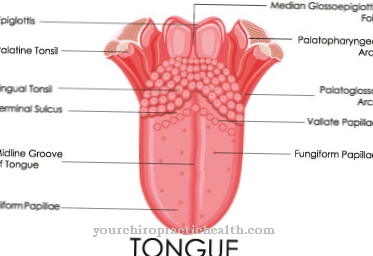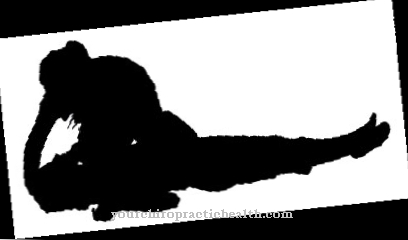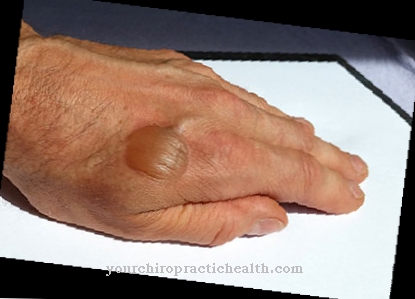At a Asthenopia it is a visual discomfort, which is caused by overexertion of the eyes as a result of internal and external influences. This so-called eye fatigue is not yet a disease, but if it persists it can lead to an eye disease in the long term. Preventive measures are important to prevent asthenopia.
What is asthenopia?

© Ralf Geithe - stock.adobe.com
Asthenopia often occurs in younger people and is characterized by a whole complex of symptoms of abnormal sensations around the eye in visually stressful situations. The term "asthenopia" comes from the Greek and means translated Eye fatigue. Especially in today's computer age, asthenopia is playing an ever increasing role.
It can be assumed that almost everyone suffers from eye fatigue at least at times. Even if you concentrate on a certain fixed point for a longer period of time, the eyes are overstrained. In addition to slight visual disturbances, eye pain or even headache can occur. The causes are varied.
These can be both organic and functional in nature. Often it is an overuse of the eye muscles. Six small eye muscles are responsible for the activity of the eye lens. If one of these muscles is overexerted, the coordination of the entire eye muscles is no longer guaranteed. The images generated by the lenses can no longer be perceived as a whole. This leads to blurring of images or double vision.
causes
The causes of asthenopia include, among other things, inadequately corrected ametropia, pre-existing coordination disorders of the eye muscles, accommodative disorders, general exhaustion or fatigue, psychological stress, neuralgia or conjunctivitis. Inadequately corrected ametropia (farsightedness or nearsightedness) due to the wrong choice of glasses or contact lenses strain the eye muscles so that they are quickly overloaded.
Coordination disorders of the eye muscles are expressed by uncoordinated movements of certain muscle groups in both eyes. So both eyes should move together in the same direction. However, there are coordination disorders in which there is a convergence movement of the eyes. Latent squint or the motor disorder of seeing both eyes together belong to the coordination disorders.
Accommodation disorders are characterized by the inadequate ability to combine the individually generated images of each eye into one overall image. Over-exertion of the eye muscles can also lead to long-term fixation on a certain point during concentrated activities. Particularly concentrated work on the computer can quickly tire the eyes. The same goes for reading in poor lighting conditions.
The eyes need a certain brightness for this, because otherwise the incidence of light would have to be regulated by changing the size of the pupils. This results in rapid overworking of the muscles. Finally, psychological influences also have an effect on the eye muscles. Of course, inflammatory processes in the eye, in the conjunctiva or in the nerves of the eye also have an effect on the resilience of the eyes.
You can find your medication here
➔ Medicines for visual disturbances and eye complaintsSymptoms, ailments & signs
Asthenopia is characterized, among other things, by rapid fatigue, heavy eyelids, exhaustion and headaches. Often there is double vision or blurred vision. The eyes are red and often watery. Eye pain occurs very often. Dizziness is also observed. This is just a response to eye strain, not a disease. However, chronic eye strain can damage the eyes over the long term.
Diagnosis & course
If the eyes show signs of fatigue, it is initially assumed that they are overstrained. However, real eye diseases should be excluded from the differential diagnosis. It is important for therapeutic measures to identify any ametropia, coordination disorders or accommodative disorders of the eyes. As part of an anamnesis, it can also be found out whether strenuous computer activities, reading in poor lighting conditions or other eye-straining activities lead to eye fatigue.
Complications
Asthenopia manifests itself through a number of symptoms, which can lead directly and indirectly to further complications. First of all, the visual impairment causes the eyelids to feel heavy, which is accompanied by rapid fatigue and general malaise. The result is headache, dizziness and blurred vision, rarely double vision and severe eye pain.
If these symptoms persist, eye reddening and eye rims develop, and sometimes eyesight also decreases. The strong fatigue quickly develops into a full-blown exhaustion and can contribute to the development of a burn-out syndrome or depression later on. The general malaise contributes to this negative spiral and severely limits those affected in their options.
The asthenopic complaints usually have a significant impact on the quality of life of those affected. If the symptoms are not treated, the symptoms increase rapidly and make everyday and professional tasks much more difficult. The chronic symptoms may subsequently develop into psychological disorders that are associated with further complications, while the physical strain can lead to a variety of secondary diseases and exacerbate existing diseases. If the asthenopic symptoms are treated early, long-term effects are unlikely.
When should you go to the doctor?
If you have asthenopic symptoms, you should definitely see an ophthalmologist. For example, if you experience dizziness, blurred vision, and heaviness in your eyelids, you most likely have an eye disease. Medical diagnosis and treatment is necessary to prevent further deterioration in eyesight. A doctor's visit is particularly urgent if the symptoms are associated with rapid fatigue and general malaise.
Accompanying headaches, red eyes and double vision are clear warning signs that should be clarified at the next opportunity. The symptoms typically occur during the day or with increasing visual stress. Asthenopia manifests itself, for example, after intensive screen work or after reading long texts.
If the symptoms mentioned occur with exhaustion, excessive fatigue or psychological complaints, we recommend talking to your family doctor. Other contact persons are the ophthalmologist or optician, depending on the type and severity of the asthenopia. Under medical supervision, the most causal ametropias of the eye can be reliably diagnosed and treated.
Doctors & therapists in your area
Treatment & Therapy
The treatment of asthenopia also largely depends on the willingness of those affected. If ametropia is detected, the correct glasses or contact lenses should be determined with the help of an optician or ophthalmologist. Eye drops can be given for a certain time to relax the eye muscles.
The treatment of inflammatory processes in the conjunctiva and eye nerves is also important. Of course, sleep and relaxation exercises also help. This is especially true in the case of functional disorders due to psychological influences. Convergence problems are often corrected with prism glasses or eye exercises.
Correction through prism glasses represents an intervention in the eye muscle balance. Since improper use can cause serious side effects, this procedure may only be carried out by an ophthalmologist. In certain cases, squint operations may be necessary. In the case of some anomalies such as fixation disparity, suitable solutions for a therapy are still being sought.
Outlook & forecast
The prognosis of asthenopia is good if the patient cooperates and is determined to improve. Without medical support, various self-help measures can be taken, which can also help alleviate the symptoms. In some patients, this method is already sufficient to achieve healing. The severity of the asthenopia is largely decisive for this.
If it is mild, the reduction of stress, relaxation techniques and adequate sleep can already bring about significant relief or healing. With medical care, the options are more diverse and comprehensive. However, the best prognosis comes from the connection between medical treatment and self-employment.
With visual aids, targeted training of the eye and self-reliant exercises to relieve the eye, the patient can achieve freedom from symptoms that is permanent. The wearing of visual aids should be done according to the instructions of the optician or ophthalmologist for an optimal result. As soon as these are no longer used, there is a risk of a relapse of asthenopia and thus deterioration in vision.
In some cases, surgery is done to correct it. This happens routinely and is associated with a quick prospect of improvement. Afterwards, however, you should take responsibility for maintaining your health.
You can find your medication here
➔ Medicines for visual disturbances and eye complaintsprevention
Preventive measures to prevent asthenopia are particularly important. If you have to work a lot with the monitor, you should regularly take breaks from the screen. We recommend a few minutes every hour with your eyes away from the computer. It would be best to look out of the window without focusing on a certain point.
Eye exercises between strenuous work on the computer can also relax the eye muscles. Appropriate lighting of the computer workstation is also important. Information should be absorbed not only through the computer or television, but also through reading newspapers, magazines or books. To ensure good blood flow to the head and eyes, it is recommended that the head and neck be kept upright. This can be supported by a regular massage in the collar area.
Aftercare
With asthenopia, there are only a few options for follow-up care available to those affected. The disease usually only needs to be treated if it persists and if the symptoms do not go away on their own. However, the life expectancy of the patient is not negatively affected by asthenopia.
In most cases, the symptoms can be relieved with the help of glasses or contact lenses. However, the patient should always wear the visual aid in order not to strain the eyes unnecessarily. If the asthenopia is not treated, in the worst case scenario, the affected person may become completely blind.
In some cases, eye drops can also be used to relieve the discomfort. This should also be taken regularly. Furthermore, relaxation exercises are possible that can alleviate the symptoms. These can also be done anytime symptoms of asthenopia appear or make life difficult.
In serious cases, however, the patient is dependent on an operative intervention. After such an operation, the body must be spared and the person affected should rest. You should therefore refrain from strenuous activities.
You can do that yourself
What those affected can do about asthenopia depends primarily on the specific trigger of the disorder. If asthenopia is triggered by overexertion of the eyes through excessive screen work, preventive measures are of particular importance.
If you work a lot with your computer or sit in front of other monitors, you should regularly take a break from the screen. This should be at least four to five minutes per working hour. During this time, keep your eyes away from the computer or other monitor. It is most effective to stand by the window and let your gaze wander over the landscape.
Alternatively, targeted eye exercises can also be performed. The eyes should be rolled clockwise for about half a minute and then in the opposite direction. Repeated violent blinking over a period of about ten seconds protects the eyes from drying out. A short phone call can also relax your eyes. Writing SMS, on the other hand, is counterproductive.
The workplace should be ergonomically designed and allow upright sitting to prevent tension in the neck and ensure good blood flow to the eyes.
If the asthenopia is due to ametropia, the visual aid prescribed by an ophthalmologist should be used constantly.Those who find glasses annoying can switch to contact lenses.





.jpg)







.jpg)

.jpg)











.jpg)